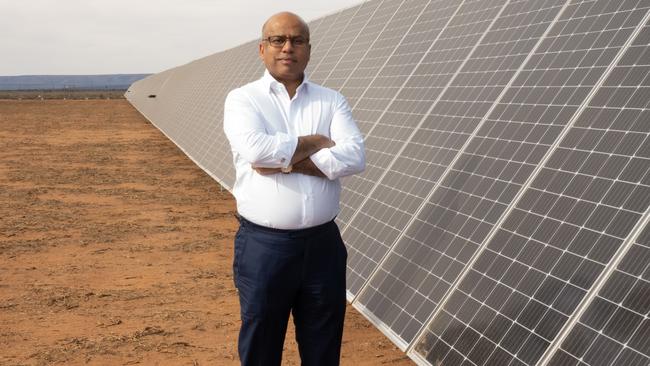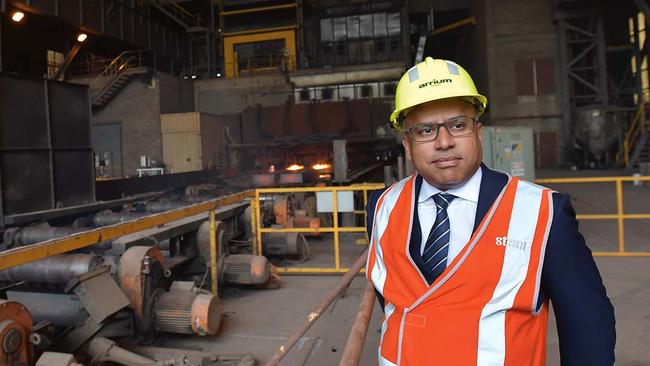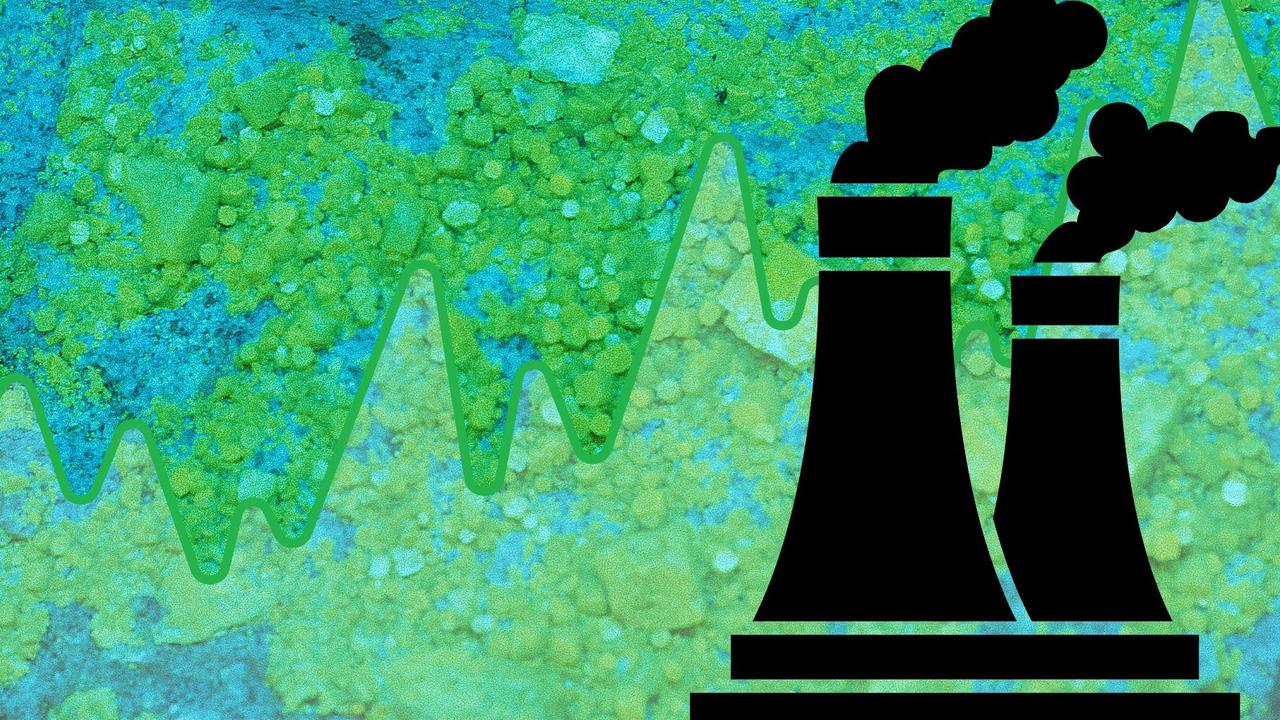Sanjeev Gupta told to ‘get on with it’ after yet another delay to Whyalla’s steel plans
Faith that Sanjeev Gupta’s GFG Alliance can deliver on its promises to modernise the Whyalla steelworks have worn thin, while his European assets face their own challenges.

Business
Don't miss out on the headlines from Business. Followed categories will be added to My News.
British industrialist Sanjeev Gupta, once feted as a white knight for coming to the rescue of the Whyalla steelworks, is facing nothing less than calls for him to be ousted from the steelmaking industry across Europe, where trade union bodies claim his “irresponsible management” has tens of thousands of people fearing for their jobs.
Sadly, similar fears are being expressed in the South Australian steel town, where the community has had a gutful of the promises made over the past seven years by Mr Gupta and his companies, GFG Alliance and Liberty Primary Metals Australia – the vehicle which owns the steel mill and associated iron ore mines.
None of those promises, which ran into several billions of dollars’ worth of potential investment, have come to fruition, and the steelworks’ blast furnace currently lies idle, having “gone cold” weeks ago
Current estimates are that it won’t be producing steel again until about mid June.

Meanwhile, a promise to build a new electric arc furnace to replace the ageing coal-fired blast furnace at the steelworks was this week pushed back another two years to 2027.
Not that the delay was revealed per se; it was slipped into a positive update on testing of the Whyalla ore which will be fed into the new furnace.
And the state’s Energy and Mining Minister, Tom Koutsantonis, swung by the headquarters of Italian steel equipment supplier Danieli this week to “eyeball” those charged with designing the integrated direct reduced iron plant and electric arc furnace (DRI-EAF) which will supposedly be built at Whyalla.
Mr Koutsantonis told ABC Radio on Friday he met with Mr Gupta in Rotterdam this week, then headed off to Italy to see Danieli.
He said he was very surprised that between those two meetings a press release went out pushing the start date back two years, and expressed frustration with GFG.
“I found the timing of that press release very, very interesting to say the least,’’ Mr Koutsantonis said.
“We had been given assurances that the electric arc furnace would completed by 2025. As I was on my way to meet the people who are building it, a press release went out, saying it was 2027.
“There are no excuses left, it’s time to get on with it. All of us have had enough of the big reveals. I think it’s now time to put the head down, bum up and get on with it.’’
The minister said he was confident about Danieli’s abilities to deliver, and said he saw a contract and evidence that a deposit had been paid.
The steelworks is arguably integral to the state government’s own $593m hydrogen hub plans for Whyalla, and the state and federal governments have committed a combined $110m-plus to get the arc furnace built – naturally contingent on the process actually going ahead.
Over in Europe, where Mr Gupta’s GFG Alliance went on a steelworks and manufacturing buying spree in the years before buying the Whyalla operations out of administration in 2017, there is no longer any pretence to politeness on the behalf of the workers caught up in GFG’s troubles.

Trade union umbrella bodies industriAll Europe and IndustriALL Global Union, which claim to represent millions of workers in mining, energy and manufacturing across Europe and worldwide, “are calling for an end to Mr Gupta’s irresponsible management which is putting Europe’s strategic steel production at risk’’.
The unions claim several blast furnaces have been idled, with production capacity at a “dramatically low level’’.
“More than 20,000 steelworkers in Czechia, Poland, Romania, Belgium, Luxembourg, Italy and Hungary are either at home with no work or nervously waiting to find out what their future hold,’’ the union said in a statement in February.
“The situation in Czechia is catastrophic: in addition to the 6000 workers in Ostrava waiting to hear if and when production will resume, 30,000 indirect jobs and 117 subcontractors are at risk.’’
The unions have called on Mr Gupta to give full transparency over his finances, and for the European Commission to set up a crisis task force.
“Workers in GFG sites have reached breaking point,’’ acting joint general secretary of IndustriALL Europe Judith Kirton-Darling said.
“Our steel industry is strategic – vital for climate action and our security. It should not be a toy for irresponsible owners – our industrial future is too important.’’
European business news outlet BNE Intellinews reported last week that the Czech government had accused Liberty of having outstanding social security payments and quoted Minister of Finance Zbynek Stanjura as saying its restructuring plans for its Ostrava steel mill – the largest in the nation employing about 6000 people – were “unrealistic’’.
“We are seeing a more than half a year-long constant transgression of (its) own commitments, goals, not meeting promised things,” Labour Minister Marian Jurecka was quoted as saying on Czech television.
“It would be a different attitude and different search of possible solutions and forms of co-operation if there was an owner here who submits plans that are realistic,” Mr Jurecka reportedly said in a separate statement.
The Ostrava mill had its power supply cut off in December due to non-payment of debts, various media reports indicate, while business outlet GMK Center has reported that the Czech operations’ second largest creditor was Danieli – the very Italian equipment manufacturer contracted to supply the Whyalla EAF, and which was contacted to supply two EAFs to Ostrava.
Work on those has apparently stopped, “due to lack of funds” GMK reports, while the Ostrava blast furnace is also currently idle.
Liberty said in a press release earlier this month it was putting in place a restructuring plan for the Czech operations which was approved by “an overwhelming majority of its creditors’’, excluding Tameh.
On Thursday this week Liberty also announced a “strategic review” of its downstream steel operations in Western Europe “in response to expressions of interest from multiple parties’’.
“The review will evaluate Liberty’s assets in Liège (Belgium), Dudelange (Luxembourg), and Piombino (Italy) and will be facilitated by specialist global investment bankers Jefferies LLC,’’ the company said on Thursday.
Meanwhile back home in Australia, the strategic importance of the steelworks cannot be overstated.
The Whyalla steelworks is the only producer of steel long products in the nation, and there was grave concern when its previous owner, Arrium, fell into administration in April 2016.
Administrator KordaMentha sought bids for the steelworks and iron ore operations from global firms, with a consortium including Korean steelmaker Posco as well as private equity partners, and GFG, emerging.

The Posco bid was named the front runner, with the company promising to bring its Finex technology to the state – impressing Mr Koutsantonis at the time.
A last ditch, “far superior” bid from Mr Gupta edged out Posco however, with GFG’s less conditional offer and less radical plans for the steelworks winning the day.
Less than a year after taking ownership of the business, GFG held a “big reveal” in Whyalla, promising a new steel plant capable of producing 10 million tonnes per year – more than five times the current capacity.
One gigawatt, or $US1bn, of renewable energy investment was promised – later upgraded to 10GW – including pumped hydro in the Middleback Ranges and vast tracts of solar panels.
That level of energy production is several times the state’s entire use on most days.
Mr Gupta later floated the idea of building a copper smelter in the region, to take advantage of all of that cheap energy.
Bringing vehicle manufacturing back to Adelaide in the form of electric cars was another plan.
None of these plans have eventuated, and one Whyalla source this week said that beyond a handful of solar panels installed in the early stages, the major Cultana solar project currently constitutes “a fence”.
To solidify his bona fides among Australia’s business elite, Mr Gupta spent $34m buying the Bomera mansion on Sydney Harbour, and sponsored the Port Adelaide AFL football team.
That’s a particularly sore point at the moment, as Mr Gupta hit Adelaide for the recent AFL Gather Round.
He didn’t take the opportunity while in the state to meet with local MP Eddie Hughes or the Whyalla council, however.
Given that GFG’s local employees are currently working reduced shifts and some have taken a 30 per cent pay cut while the blast furnace is offline, showing his face in town may have been politic.
Former and current workers who spoke to The Australian this week said the community conversation has swung to who might be the next owner of the steel mill.
There is little faith that the DRI-EAF facility will be built, and bemusement that a previously announced steel mill seems to have fallen off the planning table altogether.
A feasibility study on the new facility is not expected before about the end of this year; the new arc furnace was meant to be built and operational in 2025 according to a press release in April last year.
And guesstimates of the cost put it at $1bn, which would need to be financed.

As one source remarked to The Australian, “who’d get into bed with Gupta?”
Local state MP Eddie Hughes said the initial concern among the community was getting the blast furnace back online.
“The immediate issue is getting the blast furnace back operating, but there are some ongoing issues at the steelworks,’’ Mr Hughes said.
“The Whyalla community has been through a lot over the years and we just want clarity, and we want certainty.
“And what we’re getting instead is a constant moving of the goalposts.’’
Mr Hughes said Mr Gupta hadn’t been to town recently as far as he knew.
“He was in the in the state for the for the Gather Round football,’’ Mr Hughes said.
“I would have thought that given what Whyalla is going through, given the loss of pay amongst his permanent employees, given contractors and labour hire people being impacted, it would been an appropriate time to come to Whyalla and just front up.
“As far as I know he hasn’t been to Whyalla for an extended period of time now.’’
Despite its difficulties, Liberty Primary Metals Australia has been among the best performers in the GFG stable.
It turned a profit of $143.2m last financial year, albeit down from a $434.3m profit the previous year.
The impact of a months-long shutdown of the Whyalla blast furnace on the bottom line remains to be seen, and the company is still grappling with a large debt load following the failure of its financier Greensill in 2021, which threatened at the time to bring down GFG as well.

A spokesman for GFG told The Australian on Friday the company has “invested over a billion dollars in the steelworks since acquiring the loss-making business in 2017, signifying our unwavering commitment to creating a sustainable, world-class operation in Whyalla’’.
“GFG has maintained the current facilities while also investing significantly in the future.
“Our clear focus and commitment is the transformation of Whyalla, a once in a generation step change, into a sustainable green steel future.
“Our investments will see the delivery of two state-of-the-art technologies by 2027 – the direct reduction iron plant capable of running on green hydrogen or natural gas, hot charging DRI into an electric arc furnace capable of running on directly fed renewable energy.
“It remains our commitment that the blast furnace will be operated delivering high quality steel, rail and structural steel to the Australian market like we have done for over half a century, until the DRI and EAF are successfully commissioned to replace the blast furnace, protecting both the Australian markets, and the community of Whyalla.’’
More Coverage
Originally published as Sanjeev Gupta told to ‘get on with it’ after yet another delay to Whyalla’s steel plans





